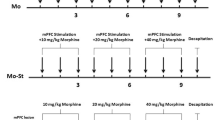Abstract
Morphine is among the most effective analgesics. However, many evidences suggest that, besides the well-know analgesic activity, repeated opioids treatment can induce some side effects such as dependence, hyperalgesia and tolerance. The mechanism of noxious information transmission in the central nervous system after dependence is not clear. An important neurotransmitter, dopamine (DA) participates not only in the process of opioid dependence but also in pain modulation in the central nervous system. In the present study we observed changes of electrical activities of pain-excitation neurons (PENs) and pain-inhibition neurons (PINs) in the caudate nucleus (Cd) following the development of morphine dependence. We also observed the role of DA on these changes. Our results revealed that both the latency of PEN discharges and the inhibitory duration of PIN discharges decreased, and the net increased values of PEN and PIN discharges increased in the Cd of morphine dependent rats. Those demonstrated that electrical activities of both PENs and PINs increased in morphine dependent rats. DA inhibited the electrical activities of PENs and enhanced those of PINs in morphine dependent rats.




Similar content being viewed by others
References
Benyamin R, Trescot AM, Datta S, Buenaventura R, Adlaka R, Sehgal N, Glaser SE, Vallejo R (2008) Opioid complications and side effects. Pain Physician 11:105–120
Ballantyne JC, Shin NS (2008) Efficacy of opioids for chronic pain: a review of the evidence. Clin J Pain 24:469–478
Koob GF, Le Moal M (2005) Plasticity of reward neurocircuitry and the ‘dark side’ of drug addiction. Nat Neurosci 8:1442–1444
Wood PB (2008) Role of central dopamine in pain and analgesia. Expert Rev Neurother 8:781–797
Treister R, Pud D, Ebstein RP, Laiba E, Gershon E, Haddad M, Eisenberg E (2009) Associations between polymorphisms in dopamine neurotransmitter pathway genes and pain response in healthy humans. Pain 147:187–193
Meyer PJ, Morgan MM, Kozell LB, Ingram SL (2009) Contribution of dopamine receptors to periaqueductal gray-mediated antinociception. Psychopharmacology 204:531–540
Altier N, Stewart J (1999) The role of dopamine in the nucleus accumbens in analgesia. Life Sci 65:2269–2287
Coffeen U, López-Avila A, Ortega-Legaspi JM, del Angel R, López-Muñoz FJ, Pellicer F (2008) Dopamine receptors in the anterior insular cortex modulate longterm nociception in the rat. Eur J Pain 12:535–543
Ansah OB, Leite-Almeida H, Wei H, Pertovaara A (2007) Striatal dopamine D2 receptors attenuate neuropathic hypersensitivity in the rat. Exp Neurol 205:536–546
Magnusson JE, Fisher K (2000) The involvement of dopamine in nociception: the role of D1 and D2 receptors in the dorsolateral striatum. Brain Res 855:260–266
Milton AL, Everitt BJ (2010) The psychological and neurochemical mechanisms of drug memory reconsolidation: implications for the treatment of addiction. Eur J Neurosci 31:2308–2319
Koob GF, Volkow ND (2010) Neurocircuitry of addiction. Neuropsychopharmacology 35:217–238
Zhao CY, Yan LX, Lu N, Zhang JY, Xu MY (2001) Making the model quickly for morphinomania in rats. J Harbin Med Univ 35:257–258
Louis P, Ann P, Anna C (1979) A stereotaxic atlas of the rat brain, 2nd edn. Plenum Press, New York, pp 81–85
Zhang XT (1973) The integration of thalamus in the process of acupunctureanalgesia. Sci China 1:28–52
Sun MZ, Chen LS, Gu HL, Cheng J, Yue LS (1980) Effect of acupuncture on unit discharge in nucleus parafascicularis of rat thalamus. Sheng Li Xue Bao 32:207–213
Neugebauer V (2006) Subcortical processing of nociceptive information: basal ganglia and amygdale. Neurology 81:141–158
Laulin JP, Larcher A, Célèrier E, Le Moal M, Simonnet G (1998) Long-lasting increased pain sensitivity in rat following exposure to heroin for the first time. Eur J Neurosci 10:782–785
Laulin JP, Célèrier E, Larcher A, Le Moal M, Simonnet G (1999) Opiate tolerance to daily heroin administration: an apparent phenomenon associated with enhanced pain sensitivity. Neuroscience 89:631–636
Célèrier E, Laulin JP, Corcuff JB, Le Moal M, Simonnet G (2001) Progressive enhancement of delayed hyperalgesia induced by repeated heroin administration: a sensitization process. J Neurosci 1:4074–4080
Zhang GW, Yang CX, Gao HR, Zhang D, Zhang Y, Jiao RS, Zhang H, Liang Y, Xu MY (2010) Microinjection of different doses of norepinephrine into the caudate putamen produces opposing effects in rats. Neurosci Lett 471:125–128
Wood PB (2006) Mesolimbic dopaminergic mechanisms and pain control. Pain 120:230–234
Austin PJ, Beyer K, Bembrick AL, Keay KA (2010) Peripheral nerve injury differentially regulates dopaminergic pathways in the nucleus accumbens of rats with either ‘pain alone’ or ‘pain and disability’. Neuroscience 171:329–343
Treister R, Pud D, Ebstein RP, Laiba E, Gershon E, Haddad M, Eisenberg E (2009) Associations between polymorphisms in dopamine neurotransmitter pathway genes and pain response in healthy humans. Pain 147:187–193
Sheng HY, Qu CL, Huo FQ, Du JQ, Tang JS (2009) D2-like but not D1-like dopamine receptors are involved in the ventrolateral orbital cortex-induced antinociception: a GABAergic modulation mechanism. Exp Neurol 215:128–134
Dang YH, Xing B, Zhao Y, Zhao XJ, Huo FQ, Tang JS, Qu CL, Chen T (2011) The role of dopamine receptors in ventrolateral orbital cortex-evoked antinociception in a rat formalin test model. Eur J Pharmacol 657:97–103
Greco R, Tassorelli C, Armentero MT, Sandrini G, Nappi G, Blandini F (2008) Role of central dopaminergic circuitry in pain processing and nitroglycerin-induced hyperalgesia. Brain Res 1238:215–223
Spangler R, Goddard NL, Avena NM, Hoebel BG, Leibowitz SF (2003) Elevated D3 dopamine receptor mRNA in dopaminergic and dopaminoceptive regions of the rat brain in response to morphine. Brain Res Mol Brain Res 111:74–83
Acknowledgments
This project was supported by China Postdoctoral Science Foundation (20080440913) and Heilongjiang province Postdoctoral Science Foundation (20080306).
Author information
Authors and Affiliations
Corresponding author
Additional information
Ying Zhang and Fengmin Zhang authors contributed equally to this work.
Rights and permissions
About this article
Cite this article
Zhang, Y., Zhang, F., Yang, C. et al. Dopamine Affects the Change of Pain-Related Electrical Activity Induced by Morphine Dependence. Neurochem Res 37, 977–982 (2012). https://doi.org/10.1007/s11064-011-0690-0
Received:
Revised:
Accepted:
Published:
Issue Date:
DOI: https://doi.org/10.1007/s11064-011-0690-0




